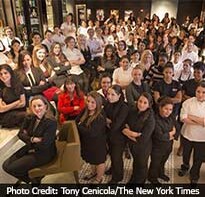Last week at Marea, a New York haunt of the powerful and the polished, Lauren DeSteno moved up from executive sous-chef to chef de cuisine. It may sound like a mere tweak of a title, but in a small way it is revolutionary.
Advertisement
Advertisement
Advertisement
Advertisement
For the latest food news, health tips and recipes, like us on Facebook or follow us on Twitter and YouTube.
Advertisement
